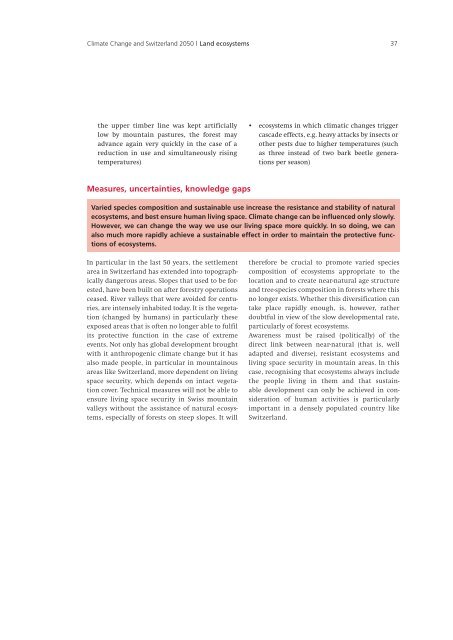Climate Change and Switzerland 2050 - OcCC - SCNAT
Climate Change and Switzerland 2050 - OcCC - SCNAT
Climate Change and Switzerland 2050 - OcCC - SCNAT
You also want an ePaper? Increase the reach of your titles
YUMPU automatically turns print PDFs into web optimized ePapers that Google loves.
<strong>Climate</strong> <strong>Change</strong> <strong>and</strong> Switzerl<strong>and</strong> <strong>2050</strong> | L<strong>and</strong> ecosystems 37<br />
the upper timber line was kept artificially<br />
low by mountain pastures, the forest may<br />
advance again very quickly in the case of a<br />
reduction in use <strong>and</strong> simultaneously rising<br />
temperatures)<br />
Measures, uncertainties, knowledge gaps<br />
• ecosystems in which climatic changes trigger<br />
cascade effects, e.g. heavy attacks by insects or<br />
other pests due to higher temperatures (such<br />
as three instead of two bark beetle generations<br />
per season)<br />
Varied species composition <strong>and</strong> sustainable use increase the resistance <strong>and</strong> stability of natural<br />
ecosystems, <strong>and</strong> best ensure human living space. <strong>Climate</strong> change can be influenced only slowly.<br />
However, we can change the way we use our living space more quickly. In so doing, we can<br />
also much more rapidly achieve a sustainable effect in order to maintain the protective functions<br />
of ecosystems.<br />
In particular in the last 50 years, the settlement<br />
area in Switzerl<strong>and</strong> has extended into topographically<br />
dangerous areas. Slopes that used to be forested,<br />
have been built on after forestry operations<br />
ceased. River valleys that were avoided for centuries,<br />
are intensely inhabited today. It is the vegetation<br />
(changed by humans) in particularly these<br />
exposed areas that is often no longer able to fulfil<br />
its protective function in the case of extreme<br />
events. Not only has global development brought<br />
with it anthropogenic climate change but it has<br />
also made people, in particular in mountainous<br />
areas like Switzerl<strong>and</strong>, more dependent on living<br />
space security, which depends on intact vegetation<br />
cover. Technical measures will not be able to<br />
ensure living space security in Swiss mountain<br />
valleys without the assistance of natural ecosystems,<br />
especially of forests on steep slopes. It will<br />
therefore be crucial to promote varied species<br />
composition of ecosystems appropriate to the<br />
location <strong>and</strong> to create near-natural age structure<br />
<strong>and</strong> tree-species composition in forests where this<br />
no longer exists. Whether this diversification can<br />
take place rapidly enough, is, however, rather<br />
doubtful in view of the slow developmental rate,<br />
particularly of forest ecosystems.<br />
Awareness must be raised (politically) of the<br />
direct link between near-natural (that is, well<br />
adapted <strong>and</strong> diverse), resistant ecosystems <strong>and</strong><br />
living space security in mountain areas. In this<br />
case, recognising that ecosystems always include<br />
the people living in them <strong>and</strong> that sustainable<br />
development can only be achieved in consideration<br />
of human activities is particularly<br />
important in a densely populated country like<br />
Switzerl<strong>and</strong>.

















